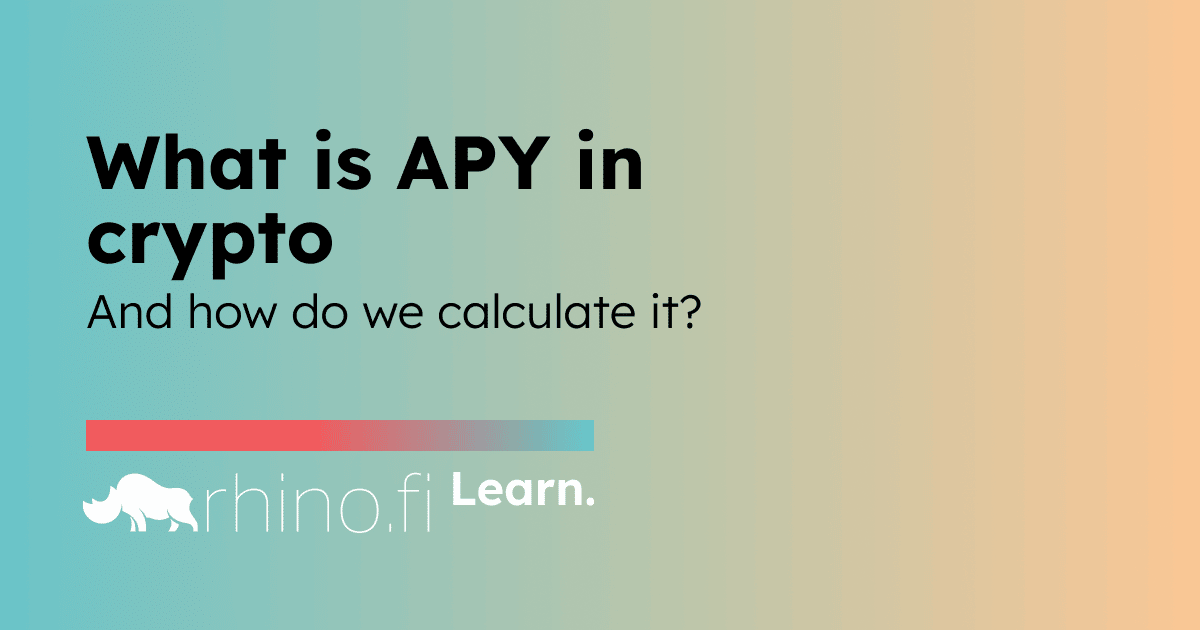Crypto’s bear market has been plagued by precipitous price plunges. The value of Bitcoin, Ethereum and other popular currencies has fluctuated by over 50% in the past year, and even the UST stablecoin has lost its dollar peg.
In this climate, traders are increasingly looking towards passive-income opportunities, which allow you to stake or invest your crypto and receive a steady return over time (think a bond or U.S. Treasury in the old world, but made digital). By committing your tokens in this way, you’re increasing overall ecosystem liquidity or supporting the work of validators, and stabilising your own portfolio at the same time.
However, before you dive into one of these opportunities, it’s important you know exactly what return you will get. You may have seen a crypto project promising you 5%, 10% or even 20% returns, but what does that actually mean in practice?
Well in all likelihood they’re referring to the APY, which determines the total amount of interest that you will earn each year (in fact if you’ve been around the scene a while, you’ve probably seen some projects promising the ‘best APY in crypto’ or something similar).
Now we know what you’re thinking: this is just the interest rate, right? Well no actually, because APY also takes the effects of compounding into account.
Crypto assets are usually compounding investments. This means that, instead of simply collecting a flat yield once a year, they harvest, and reinvest, the yield at regular ‘compounding’ intervals to boost your rewards.
At each compounding period, the interest is added onto your initial investment. Then when the next compounding interval rolls round, the interest is calculated on the updated figure, not the original.
Read More: rhino.fi









 Bitcoin
Bitcoin  Ethereum
Ethereum  Tether
Tether  XRP
XRP  Solana
Solana  USDC
USDC  Dogecoin
Dogecoin  Cardano
Cardano  TRON
TRON  Lido Staked Ether
Lido Staked Ether  Wrapped Bitcoin
Wrapped Bitcoin  Sui
Sui  Wrapped stETH
Wrapped stETH  Chainlink
Chainlink  Avalanche
Avalanche  Stellar
Stellar  Hyperliquid
Hyperliquid  Shiba Inu
Shiba Inu  Hedera
Hedera  LEO Token
LEO Token  Bitcoin Cash
Bitcoin Cash  Toncoin
Toncoin  Litecoin
Litecoin  Polkadot
Polkadot  USDS
USDS  WETH
WETH  Monero
Monero  Pi Network
Pi Network  Wrapped eETH
Wrapped eETH  Bitget Token
Bitget Token  Pepe
Pepe  Binance Bridged USDT (BNB Smart Chain)
Binance Bridged USDT (BNB Smart Chain)  Ethena USDe
Ethena USDe  Coinbase Wrapped BTC
Coinbase Wrapped BTC  WhiteBIT Coin
WhiteBIT Coin  Bittensor
Bittensor  Uniswap
Uniswap  Dai
Dai  Aave
Aave  NEAR Protocol
NEAR Protocol  Aptos
Aptos  OKB
OKB  Ondo
Ondo  Jito Staked SOL
Jito Staked SOL  Internet Computer
Internet Computer  Ethereum Classic
Ethereum Classic  Cronos
Cronos  BlackRock USD Institutional Digital Liquidity Fund
BlackRock USD Institutional Digital Liquidity Fund